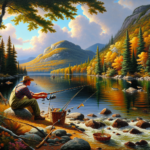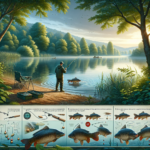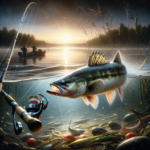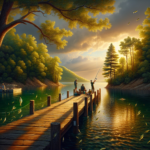Fishing in South Dakota: Lakes, Reservoirs, and Rivers
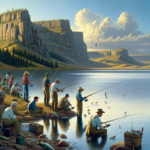
Introduction
Did you know that South Dakota is home to over 1,100 square miles of water, making it a paradise for anglers? Whether you’re a seasoned fisherman or a novice looking to cast your first line, South Dakota offers a diverse range of fishing opportunities. This article will guide you through the best lakes, reservoirs, and rivers in South Dakota, the species you can expect to catch, and the techniques and gear you’ll need for a successful fishing trip.
Fishing in South Dakota is not just a pastime; it’s a way to connect with nature, enjoy the great outdoors, and even participate in local traditions and events. From the glacial lakes in the northeast to the Missouri River’s expansive reservoirs, South Dakota’s waters are teeming with fish and adventure. Let’s dive in and explore what makes fishing in this state so special.
Background/Context
Historical or Cultural Significance
Fishing has been an integral part of South Dakota’s history and culture. Native American tribes, such as the Lakota and Dakota, relied on the state’s rivers and lakes for sustenance long before European settlers arrived. Today, fishing remains a popular activity, drawing both locals and tourists to the state’s abundant waters.
Geographical Overview
South Dakota’s diverse geography includes the rolling prairies of the east, the rugged Badlands, and the Black Hills in the west. The state’s climate varies, with cold winters and warm summers, making it essential to understand seasonal variations when planning a fishing trip. The Missouri River, which bisects the state, is a major waterway, along with numerous lakes and reservoirs created by glacial activity and damming projects.
Key Points/Details
Fishing Techniques
Technique Overview
South Dakota offers a variety of fishing techniques, including fly fishing, ice fishing, and trolling. Fly fishing is popular in the Black Hills’ streams, while ice fishing is a winter favorite on the state’s frozen lakes. Trolling is commonly used in larger reservoirs and the Missouri River.
When and Where to Use
Fly fishing is best in the spring and fall when water levels are optimal. Ice fishing is ideal during the winter months, typically from December to February. Trolling can be effective year-round but is particularly productive in the summer when fish are more active.
Recommended Gear
- Fly Fishing: 5-6 weight fly rod, floating line, and a variety of dry flies and nymphs.
- Ice Fishing: Ice auger, ice fishing rod, tip-ups, and live bait such as minnows or wax worms.
- Trolling: Medium-heavy spinning or baitcasting rod, trolling motor, and crankbaits or spinnerbaits.
Species Information
Species Overview
South Dakota’s waters are home to a variety of fish species, including walleye, northern pike, smallmouth bass, and trout. Walleye are particularly abundant in the Missouri River and its reservoirs, while trout are commonly found in the Black Hills’ streams.
Best Practices
For walleye, use jigs tipped with minnows or nightcrawlers, especially in the spring and fall. Northern pike can be caught using large spoons or live bait. Smallmouth bass are often found near rocky structures and can be caught using soft plastics or crankbaits. For trout, fly fishing with dry flies or nymphs is highly effective.
Location Information
Top Fishing Spots
- Lake Oahe: Known for its excellent walleye fishing, with numerous access points and amenities.
- Lake Sharpe: Another Missouri River reservoir, offering a variety of species including walleye, smallmouth bass, and catfish.
- Black Hills: Streams like Rapid Creek and Spearfish Creek are prime spots for trout fishing.
- Waubay Lake: Located in the northeast, this lake is famous for its perch and walleye fishing.
Regulations and Licenses
Anglers in South Dakota need a valid fishing license, which can be purchased online or at local retailers. Regulations vary by water body and species, so it’s essential to check the South Dakota Game, Fish, and Parks website for the latest rules, including catch limits and seasonal restrictions.
Seasonal Considerations
Seasonal Variations
Fishing conditions in South Dakota change with the seasons. Spring and fall are ideal for walleye and trout, while summer is great for bass and northern pike. Winter offers unique opportunities for ice fishing, particularly for perch and walleye.
Best Times to Fish
The best times to fish are early morning and late evening when fish are most active. Seasonal peaks include spring spawning periods for walleye and fall runs for trout in the Black Hills.
Events and Tournaments
Event Overview
South Dakota hosts several fishing tournaments and events throughout the year. The Governor’s Cup Walleye Tournament on Lake Oahe is one of the most prestigious, attracting anglers from across the country. Other notable events include the Lewis and Clark Walleye Tournament and various ice fishing derbies.
Preparation Tips
To prepare for a tournament, ensure your gear is in top condition, practice your techniques, and familiarize yourself with the fishing area. Pre-fishing the tournament waters can give you a significant advantage.
Tips and Best Practices
General Tips
- Always check local regulations before fishing.
- Use live bait for better success with species like walleye and northern pike.
- Practice catch and release to help sustain fish populations.
Avoid Common Mistakes
- Not checking weather conditions before heading out.
- Using the wrong type of bait or lures for the targeted species.
- Ignoring local fishing reports and conditions.
Advanced Techniques
- Mastering the use of electronics like fish finders to locate fish more effectively.
- Learning advanced casting techniques for fly fishing.
- Experimenting with different trolling speeds and depths to find the most productive patterns.
Gear and Equipment Recommendations
Essential Gear
- Fishing rod and reel appropriate for your chosen technique.
- Tackle box with a variety of lures, hooks, and weights.
- Fishing line suited to the species you’re targeting.
- Live bait or artificial lures.
Optional Gear/Upgrades
- Fish finder or sonar device.
- Portable GPS for navigating large water bodies.
- High-quality polarized sunglasses to reduce glare and see fish more clearly.
Where to Buy or Rent
Local bait and tackle shops in towns near popular fishing spots often have a wide selection of gear and knowledgeable staff. Online retailers like Bass Pro Shops and Cabela’s also offer extensive inventories. For rentals, check with local marinas and outdoor outfitters.
Safety and Conservation
Safety Tips
- Always wear a life jacket when fishing from a boat.
- Check weather forecasts and avoid fishing during severe weather conditions.
- Be aware of local wildlife and take precautions to avoid encounters with potentially dangerous animals.
Conservation Practices
- Practice catch and release, especially for larger fish that are vital for breeding.
- Follow all local fishing regulations and report any violations to authorities.
- Dispose of fishing line and other waste properly to protect the environment.
Planning Your Trip
Accommodations
South Dakota offers a range of accommodations near popular fishing spots, from campgrounds and RV parks to hotels and lodges. In the Black Hills, consider staying in Rapid City or Deadwood for easy access to trout streams. Near Lake Oahe, Pierre offers numerous lodging options.
Travel Tips
South Dakota is accessible by car via Interstate 90 and Interstate 29. The nearest major airports are in Sioux Falls and Rapid City. Renting a car is recommended for reaching remote fishing locations. Always check road conditions, especially in winter.
Additional Activities
South Dakota is rich in outdoor activities. Visit Mount Rushmore, explore the Badlands, or hike in Custer State Park. For families, the state offers numerous attractions, including the Reptile Gardens and Bear Country USA.
Frequently Asked Questions (FAQs)
Do I need a fishing license in South Dakota?
Yes, a valid fishing license is required for all anglers aged 16 and older. Licenses can be purchased online or at local retailers.
What is the best time of year to fish in South Dakota?
The best time varies by species, but generally, spring and fall are ideal for walleye and trout, while summer is great for bass and northern pike. Winter is perfect for ice fishing.
Can I fish in South Dakota’s state parks?
Yes, many state parks offer excellent fishing opportunities. Check with individual parks for specific regulations and access points.
Conclusion
Fishing in South Dakota offers a unique and rewarding experience, whether you’re targeting walleye in the Missouri River or fly fishing for trout in the Black Hills. By understanding the best techniques, species habits, and top fishing spots, you can make the most of your time on the water. Remember to follow local regulations, practice conservation, and prioritize safety to ensure a successful and enjoyable fishing trip. So grab your gear, head to South Dakota, and start making memories on its beautiful lakes, reservoirs, and rivers.

